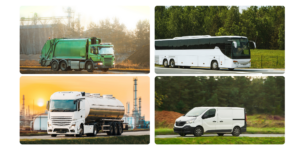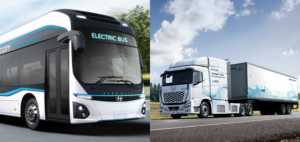Keeping Goods Moving in a Growing Economy
The ability for goods to move freely is essential for a flourishing economy. This movement relies on a network of professional drivers and commercial vehicles. From long-haul transport to last-mile delivery, ensuring that commercial vehicles can evolve as our demands and needs expand is essential to moving this economic engine forward. In fact, the American Trucking Association estimates the US tonnage moved in 2024 will grow from 11.27 billion to 13.99 billion tons by 2035.
Source: ATA’s Freight Transportation Forecast 2024 to 2035
Driving Growth with Common Platforms
The automotive industry must deliver a broad spectrum of commercial vehicles to meet growing demand. OEMs increasingly focus on streamlining development processes to support diverse customer segments on common vehicle platforms. Reusing common E/E infrastructure elements including electronic controllers, networks, sensors, actuators, and software modules across different types and classes of vehicles, from long-haul semis to mid-mile delivery trucks is a way to achieve that.

Simultaneously, as after-sales support and services play a bigger role in OEMs’ profitability, providing digital services to improve operational efficiency for diverse types of fleets is equally paramount.
For instance, Class 6 to 8 commercial trucks share the same underlying E/E, but are software configurable based on the application like transporting goods over the highway or moving goods within a very large shipping yard. Alternatively, Class 3 to 5 vehicles can be used in last-mile delivery or shepherding passengers. A common E/E platform can easily change from keeping goods in a controlled environment to keeping people comfortable in transit.
Unlocking New Value Through Software-Defined Commercial Vehicles
Adopting a common platform will enable commercial vehicle manufacturers to capture this future demand. A software-defined vehicle architecture is the paradigm shift for commercial vehicle OEMs to streamline production and create new business models based on digital services. These services can enhance vehicle functions, driver comfort, provide over-the-air updates, and create entirely new data-driven solutions that support real-time decision-making. The commercial vehicle industry can evolve beyond products for one-time sales to offering digital platforms for transportation and logistics services.
To seize these emerging technological advancements, OEMs must look to digitalize the entire value chain which starts right from how vehicles are architected. That requires a shift away from traditional vehicle architecture and towards a flexible electrical and electronic (E/E) architecture. According to McKinsey & Company, revenue from control units is expected to experience a significant slowdown by 2030, with a compound annual growth rate of only 1.4%. This trend can be attributed to the increased computing power, centralization of vehicle resources, and the increasing adoption of a commercial SDV architecture.
Source: The big shift: Moving commercial vehicle OEMs to centralized E/E and Software
Empowering the Future of Commercial Vehicles with the Sonatus Foundation
Sonatus Foundation brings the software-defined vehicle (SDV) vision to life. Foundation delivers adaptability at its core, enabling highly configurable network topologies that support seamless interoperability across vehicle subsystems. At Sonatus, we believe that a software-defined vehicle platform provides the flexibility OEMs need to future-proof their vehicle platforms. Commercial OEMs are empowered to tailor their platforms for a wide range of use cases—whether accommodating different combinations of sensors, actuators, and cameras or supporting segment-specific applications for diverse transport and fleet needs. As an example, a common platform will allow applications to be hardware agnostic and easily upgradable compared to completely rewiring the vehicle. By offering a common platform that can evolve with changing requirements, Foundation ensures that commercial OEMs can efficiently connect network, data, application, and security services from the vehicle to the cloud.
Networking Services
Implement a software-defined network strategy separating the network control and data planes so vehicle networks, including CAN, Ethernet, and J1939, can be easily monitored, configured, and managed centrally. This makes it easy to adapt existing and new E/E architectures as new systems, sensors, actuators, and other elements are added to vehicles.
Data Services
Ensure that the vehicle infrastructure supports easy, secure, and cost-effective access to vehicle signals and diagnostic data from sensors, electronic control units (ECUs), and other local storage. This is achieved through features such as network-shared storage, diagnostics manager, and log analysis services.
Application Services
Manage real-time application computing resources within vehicles to guarantee optimal performance and dynamic service orchestration across systems. This is supported by a service-oriented architecture (SOA) manager which ensures seamless data exchange and interoperability among ECUs. Container manager ensures computing resources are optimal and configurable according to the application workload.
Commercial SDVs Powering OEM Innovation to Tackle Fleet Challenges Head-On
Establishing a strong foundation is simply the beginning for commercial SDVs to bring more value to their customers. OEMs need additional tools to support fleets and customers post-sales. Collector AI, Automator AI, and Updater are a suite of products Sonatus offers that will enable commercial OEMs to abstract software services that deliver value-added solutions and address the most pressing issues for their customers.
Collector AI
Collect precise vehicle data by deploying lightweight fine-grained policies to power data-driven services, including preventative maintenance, driver safety, and fuel savings.
Automator AI
Automate vehicle testing and diagnostics, and add tailored driving features using highly configurable trigger based in-vehicle automation policies.
Updater
Seamlessly manage vehicle-wide SOTA and FOTA updates from a single dashboard.
These products empower OEMs to deliver enabling services that help fleet operators address a wide range of challenges, including operational efficiency, safety, regulatory compliance, and maintenance.
Enhancing Safety with Software-Defined Vehicle
Commercial vehicle OEMs can use Sonatus Updater to remotely deploy safety-critical software updates across their fleets, reducing risks tied to faulty systems. By integrating it into a modular E/E architecture, OEMs can seamlessly deploy performance improvements and feature enhancements that ensure vehicles operate at peak efficiency and safety, allowing for proactive risk mitigation, improved compliance, and reduced downtime through over-the-air updates (OTAs). The result is a more agile, safe, and connected commercial vehicle ecosystem.
Navigating Compliance and Regulatory Challenges
Sonatus Collector AI allows commercial vehicle OEMs to deploy lightweight data collection policies at any time, including after sales, that enable efficient compliance monitoring and automated reporting without hardware changes. Commercial vehicle OEMs can use Sonatus Collector AI to gather real-time data on emissions, driver hours, and vehicle performance, helping meet evolving regulatory requirements. Collector AI will streamline audits, reduce manual effort, and ensure readiness for stricter standards. Ultimately, Collector AI helps OEMs stay compliant, responsive, and data-driven in a fast-changing regulatory environment.
The Operational Cost of Vehicle Maintenance
This transition to software-defined vehicles will significantly improve maintenance capabilities. Sonatus Automator AI can reduce the financial impact of maintenance and breakdowns by enabling real-time automation of in-vehicle behaviors based on data and conditions. Automator allows OEMs to remotely configure logic that triggers diagnostics, alerts, or performance adjustments when faults or wear indicators are detected. This proactive approach helps prevent costly downtime, supports predictive maintenance, and ensures upgradability for fleet owners. As a result, fleets become more efficient, reliable, and easier to maintain over time.
The Future of Software-Defined Vehicles in Commercial Vehicles

As the commercial vehicle industry continues to evolve, software-defined vehicles (SDVs) are poised to revolutionize how fleets are built, managed, and optimized. With a growing focus on connectivity and automation, the future of commercial SDVs lies in flexible, intelligent systems that can adapt in real time to operational demands and regulatory changes.
The impact of SDVs for commercial OEMs
Software-defined vehicle architectures offer a powerful opportunity to streamline manufacturing, enhance modularity, and deliver new value-added services such as remote diagnostics, over-the-air (OTA) updates, and dynamic feature deployment. This approach not only reduces production complexity but also opens doors for continuous product improvement post-sale, fostering a richer customer experience and unlocking recurring revenue streams.
The impact of SDVs for fleet operators
For fleet operators, SDVs enable more efficient centralized control and real-time monitoring of mixed vehicle types and configurations. Operators benefit from predictive maintenance, flexible reconfiguration of software functions, and integration with enterprise-level tools for logistics, compliance, and safety — all of which contribute to improved uptime and reduced total cost of ownership.
How Sonatus is making commercial SDVs a reality
Sonatus is at the forefront of this transformation, delivering cutting-edge software solutions that evolve with the industry’s rapid pace. From real-time automation and dynamic data collection to intelligent update orchestration, Sonatus is equipping OEMs and fleets with the tools they need to thrive in a software-defined era. In addition to millions of passenger vehicles in production, Sonatus technology has been deployed on numerous commercial vehicle platforms, including Hyundai’s XCIENT Fuel Cell truck and Hyundai ELEC CITY battery-electric buses, demonstrating production-ready solutions that are already reshaping the commercial vehicle landscape.
Looking ahead, Sonatus continues to push boundaries, investing in scalable platforms that support software-defined architectures. The road ahead promises smarter, safer, and more efficient commercial vehicles built not just with hardware, but with the intelligence to continually improve and adapt.
